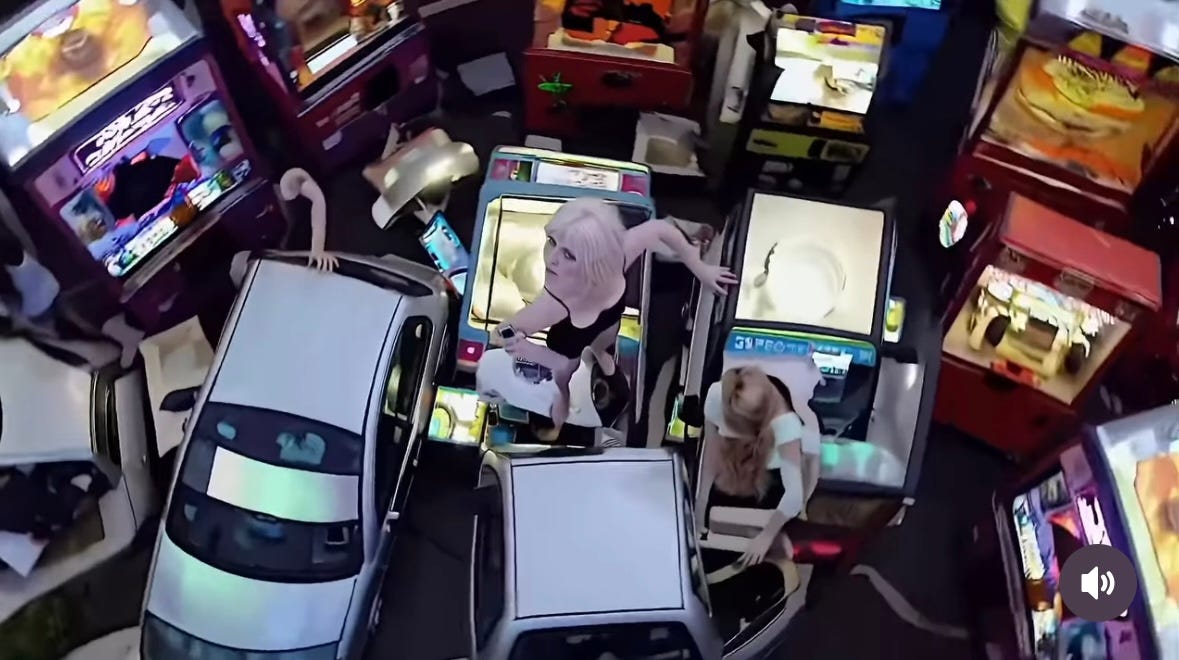The cover image to this piece on the Substack app is from Mike Gerritzen and Geoffrey Lillemor’s installation Space is the Place (2019), which explores “whether humans will survive in the constant battle between the technological future and our normal human life”

Somewhere between my third iced coffee and a video of a naked man levitating out of a giant saucer of mice and milk, I realized that irony is dead.
Not because sincerity is making a comeback, or because trying hard is cool again. But because content on the internet has gotten so absurd that it’s transcended the layer of reality where irony and sincerity mean anything at all.
Let me tell you about what I saw this morning: a man biting the head off a parakeet as it turned to cake between its teeth. A woman posing seductively atop empty beer bottles at the base of an overflowing trashcan. A grotesque, wrinkled, man-dog hybrid. At times, these videos made me laugh through the sheer force of their supreme weirdness, but most sent me into a visceral, cringing state of shock, like my brain had short-circuited. What the fuck did I just watch?
I’ve been seeing more of this reality-bending content lately. Formally—in its incoherence and sensory excess—it holds up a mirror to the media environment that produced it, in which content is served up in decontextualized, bite-sized pieces and maximum intensity is algorithmically-rewarded. Taken together, the oversaturated content landscape of social media and the incentive structures set up by the algorithms exert a kind of evolutionary pressure on content to stand out while remaining context-free, since there’s no room to establish context on an algorithmic feed. Disorientation, then, becomes an effective adaptive strategy for attracting attention through emotional intensity.
In parallel, generative AI has removed the last remaining barriers to visual production—physical laws, skill, and internal logic—to enable the creation of content that is uncanny, emotionally charged, and devoid of meaning. Bodies mutate into food then back into bodies. Faces morph through human, animal, and spaghetti-monster variations over the course of a few seconds.
We have entered the post-legible internet, where content still communicates, just not through meaning. It’s not totally illegible—if it were, it wouldn’t trigger a reaction—but it’s not legible either, because there’s nothing to understand. It occupies a strange, third zone that bypasses reasoning altogether.
We can call this the post-legible: a condition in which content no longer transmits meaning—such as through narrative, logic, or shared signs—but instead transmits affect as its primary mode of communication. It doesn’t tell you anything, but it does something to you.
Irony operates by subverting meaning, which requires meaning to exist in the first place. In post-legible vibe-space, irony dies. Content opts to zap straight into the nervous system, triggering laughter, shock, disgust, or confusion, rather than undergoing a slower metabolization through reasoning and interpretation. It’s hyper-spreadable, because it doesn’t need to be understood, just felt, to be effective.
The Italian Brainrot Animals are a notable recent example. In early 2025, the AI-generated freak-critters became a global sensation precisely because their meaninglessness, coupled with their playful emotional charge, made them so universally appealing.
In fact, there’s significant overlap between brainrot and the post-legible, but they refer to fundamentally different dimensions. Brainrot is an aesthetic, defined by visual conventions like AI slop, amateur 3D graphics, and degraded, low-res imagery. Post-legibility, in contrast, describes a communicative logic, how content transmits—or refuses to transmit—meaning, rather than how it looks.
Some, but not all, brainrot operates in the post-legible mode, and a lot of, but not all, post-legible content uses AI or the aesthetics of brainrot. The Italian Brainrot Animals started as pure post-legible artifacts, meaningless and affective, but as the Brainrot Cinematic Universe evolved, characters reappeared in relation to one another and began to form loose storylines, reintroducing internal narrative and legibility.
Lack of depth online is nothing new. Since social media’s early days, what’s gone viral has often prioritized emotional resonance over explicit meaning. Videos like Badgers, Salad Fingers, and Too Many Cooks were early examples of the post-legible—spiritual predecessors to today’s surreal media artifacts. But as absurd as they were, these early memes still had stable characters and unfolded within internally consistent worlds, even if they differed from our own.
Legibility has since unraveled further, mutating, with the help of AI, into more acutely uncanny states. Much of today’s post-legible content avoids coherence at all costs, shunning narrative altogether, embracing fluid, morphing characters, and even extending this destabilization into the physical laws of the worlds it constructs.
The more incomprehensible, the more emotionally potent, the more spreadable. Social media already runs on this logic, virality governed less by sense than sensation. Post-legible media takes this to its feverish extreme then twists it in on itself. There are moments when you can see the present take the shape of the future. These videos feel like artifacts from the eventual implosion of the internet’s current incarnation, debris, metastasized and radioactive, blown backward in time.





This makes me think of surrealism, but without the call to our unconscious. It suggests that the concept of a shared unconscious metanarrative no longer exists. That could in itself be a good thing
As Terrence McKenna prophesized around the 1980's, "technology will become more like drugs and drugs will become more like technology". The first part of his statement is becoming increasingly true. The addictiveness has been here for a while at this point, but the more psychedelic reality bending aspect has finally hit us. Technology is becoming so drug-like that what's left is pure impact on the senses. There is no inherent meaning, just some change in consciousness.
Great short article, I'll subscribe